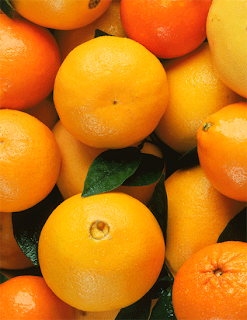The orange is a hybrid of ancient cultivated origin, possibly between pomelo (Citrus maxima) and mandarin (Citrus reticulata).
Oranges originated in Southeast Asia. The fruit of Citrus sinensis is called sweet orange to distinguish it from Citrus aurantium, the bitter orange. The name is thought to ultimately derive from the Sanskrit for the orange tree, with its final form developing after passing through numerous intermediate languages.
Citrus fruit is a source of vitamin C are useful for human health. Vitamin C content varies between varieties is round, but ranged between 27-49 mg/100 g of fruit flesh.
Orange juice contains 40-70 mg of vitamin C per 100 ml, depending on its type. The older the citrus fruit, usually diminishes as its vitamin C content, but the more sweet.
Vitamin C contained in fruit juice, meat, and leather. A quarter of the total content of vitamin C contained in citrus fruit juice. Beta-carotene (provitamin A), which forms vitamin A contained in many skin and orange juice.
A peeled sectioned navel orange. The underdeveloped twin is located on the bottom right.
A single mutation in 1820 in an orchard of sweet oranges planted at a monastery in Brazil yielded the navel orange, also known as the Washington, Riverside, or Bahia navel. The mutation causes the orange to develop a second orange at the base of the original fruit, opposite the stem, as a conjoined twin in a set of smaller segments embedded within the peel of the larger orange. From the outside, it looks similar to the human navel, hence its name.
Persian orange
The Persian orange, grown widely in southern Europe after its introduction to Italy in the 11th century, was bitter. Sweet oranges brought to Europe in the 15th century from India by Portuguese traders quickly displaced the bitter, and are now the most common variety of orange cultivated. The sweet orange will grow to different sizes and colours according to local conditions, most commonly with ten carpels, or segments, inside.
Valencia orange
The Valencia or Murcia orange is one of the sweet oranges used for juice extraction. It is a late-season fruit, and therefore a popular variety when the navel oranges are out of season. For this reason, the orange was chosen to be the official mascot of the 1982 FIFA World Cup, which was held in Spain. The mascot was called "Naranjito" ("little orange"), and wore the colours of the Spanish football team uniform.
Nutritional Value
| Nutritional value per 100 g (3.5 oz) | |
|---|---|
| Energy | 192 kJ (46 kcal) |
| Carbohydrates | 11.54 g |
| Sugars | 9.14 g |
| Dietary fiber | 2.4 g |
| Fat | 0.21 g |
| Protein | 0.70 g |
| Thiamine (Vit. B1) | 0.100 mg (8%) |
| Riboflavin (Vit. B2) | 0.040 mg (3%) |
| Niacin (Vit. B3) | 0.400 mg (3%) |
| Pantothenic acid (B5) | 0.250 mg (5%) |
| Vitamin B6 | 0.051 mg (4%) |
| Folate (Vit. B9) | 17 μg (4%) |
| Vitamin C | 45 mg (75%) |
| Calcium | 43 mg (4%) |
| Iron | 0.09 mg (1%) |
| Magnesium | 10 mg (3%) |
| Phosphorus | 12 mg (2%) |
| Potassium | 169 mg (4%) |
| Zinc | 0.08 mg (1%) |
| Percentages are relative to US recommendations for adults. Source: USDA Nutrient database | |






